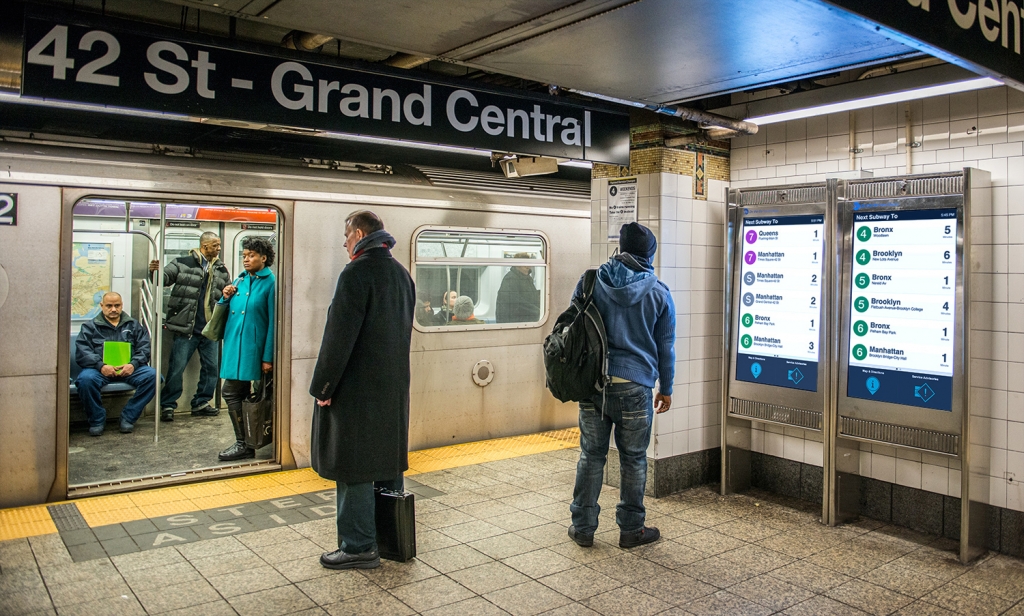In an effort to bring the New York City subway system into the 21st century, Intersection (New York City), a municipal media company, designed, developed and deployed a touch-screen-sensitive LCD-based kiosk, created as a subway navigation system for the New York City Metropolitan Transit Authority (MTA). In a public/private collaboration, Intersection’s wayfinding kiosks, known as On-The-Go, were given to the MTA at no cost with the intent that a return on investment would come from kiosk advertisements that accompany the displays.
Getting around New York City via subway is quite a challenge, with more than 665 miles of track serviced by 472 subway stations. Previously, navigating the subways had been done with paper maps and paper service alerts or by asking on-site transit officials the best way of getting from here to there by subway. More recently, travelers have been guided by smart-phone apps.
Finding On-The-Go kiosks
Intersection’s On-The-Go digital information kiosk is essentially an enhanced customer service inter-active media. The kiosks are encased in a stainless steel shell that’s 78 in. tall, 31 in. wide and 11 in. deep. The system employs FHD Samsung screens, some at 47 in., others at 55 in. All screens are portrait-formatted at 1080 x 1920 pixels. The touch-screens operate with projected capacitive touch layers. Each unit also includes stereo microphones, HD cameras, speakers and the ability to connect additional peripherals via USB. Currently, there are 185 kiosks deployed within 42 MTA subway stations throughout the city. Kiosk deployment is divided with roughly half the units installed along the subway platforms and the other half in paid mezzanine areas and unpaid entrance areas.
The kiosks are designed and manufactured to withstand the harsh transit environment, housed in stainless steel, graffiti-resistant and easy to clean. “Each kiosk is secured with a cyberlock,” said Damian Gutierrez, Intersection’s Strategy Lead, “and includes various monitoring systems including ‘door ajar’ and vibration sensors. Beyond a robust, rugged design, we’ve noticed very little vandal-ism take place, which contributes to our theory that folks will take care of public infrastructure they view as beneficial or useful.”
Passengers activating the kiosk touchscreens are offered a wealth of transit information including subway maps, real-time train arrival estimates for specific routes, a listing schedule of Metro North rail departures and service alerts for disruptions or schedule changes. When disruptions occur, the kiosk touch-screens suggest alternate routes to intended destinations. On-The-Go also informs passengers of current escalator and elevator shutdowns and provides real-time emergency alerts.
Digital advertising at your fingertips
On-The-Go’s business model calls for it to be fully funded by third-party advertising revenue, with its advertising presented on a contextual basis. It manages its ads both by “dayparting” (dividing a broadcast day into several parts and running appropriate content during those periods) and by location-basing (emphasizing local area retail and shopping access). If you are uptown (Columbus Circle) and want to visit Battery Park (Lower Manhattan), On-The-Go will present the best transit route for getting there.
Advertisement
As far as system usage goes, Gutierrez noted, “In 2016, we saw nearly 10 million taps of the arrivals button and more than 2.5 million Trip Planner route requests in total. Each month, there are millions of interactions with the kiosks. As for advertising, the New York Lottery/Tic-Tac-Toe campaign last July gene-rated the highest engagement we’ve ever seen on On-the-Go. During a two-week run, MTA customers played Tic-Tac-Toe more than 90,000 times, with nearly 50,000 users opting to play again after their first go.”
Beyond just presenting kiosk advertising, the creatives have a direct connection to smartphones as stated by Gutierrez, “We’ve found that linking mobile and large-scale transit advertising provides a great lift for advertisers. We offer the ability to send content to those mobile devices of users who opt-in via SMS, email or QR code – say to complete a transaction after browsing an interactive shopping guide running on our kiosks. In our experience, users tend to prefer SMS over the other two methods combined.”
Let your fingers do the walking
While advertising and wayfinding signage are facts of life within transit operations, Intersection digital kiosks are pushing signage to a new level of utilization for passengers, advertisers and station maintenance. For passengers, customer service has been tremendously improved with the kiosks’ real-time train information alerts and navigation. Advertisers have immediate eyeball access to kiosk users and passersby and, for station maintenance, no more postering station walls or support columns with change of service alerts. For the MTA it’s a bona fide blessing of zero cost for installation and operation. And in the best of all worlds – revenue sharing from kiosk advertising pro-grams. Overall, it appears that the future of subway wayfinding is easily described by a phrase from another era of information gathering: “Let your fingers do the walking.”



 Tip Sheet1 week ago
Tip Sheet1 week ago
 Photo Gallery3 days ago
Photo Gallery3 days ago
 Ask Signs of the Times4 days ago
Ask Signs of the Times4 days ago
 Real Deal2 weeks ago
Real Deal2 weeks ago
 Benchmarks1 week ago
Benchmarks1 week ago
 Women in Signs2 weeks ago
Women in Signs2 weeks ago
 Photo Gallery1 week ago
Photo Gallery1 week ago
 Women in Signs1 week ago
Women in Signs1 week ago









